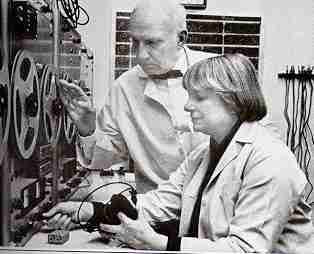

4 of 13
Phases of Excitation
Until relatively recently, we knew little about the sexual physiological responses. Masters and Johnson were the first to study physiological changes during sexual stimulation during the 1950s and 1960s (6). Their research has made possible much more specific description of the typical processes during coitus. Subsequent to these findings, Kaplan (5)specified another stage prior to excitement or arousal phase referred to as "desire phase", which describes the person's interest in and radiness for sexual activity. The desire phase occurs after the individual sees an attractive person or in reaction to some cue that makes him or her think of sex. The Sexual fantasies may also occur in the absence of any sexual cues.
 William Mastes and Virginia Johson: The pioneers of sexual research |
Masters and Johnson developed
methods and equipment and used physiological measures to monitor adult
volunteers engaging in sexual activity.
Their techniques included simple measurement of anatomical parts during different phases of stimulation, intrauterine electrodes to measure uterine contractions, electrocardiograph tracing to monitor rate and level of cardiac contractions, as well as equipment to measure respiration and blood pressure. Data were collected during masturbation as well as during natural and artificial coitus. The optical properties of plastic penises used for artificial coitus allowed observation and recording of intravaginal physiological responses. |
Back to the first page of this article
Author: Dr. Silvia Helena Cardoso, PhD. Psychobiologist, master and doctor in Sciences by the University of São Paulo and post doctoral fellowship by the University of California, Los Angeles. Invited Professor and Associate Researcher of the Center for Biomedical Informatics, State University of Campinas (Unicamp), Brazil.
Center for Biomedical Informatics
State University of Campinas, Brazil
Copyright 1997 State University of Campinas